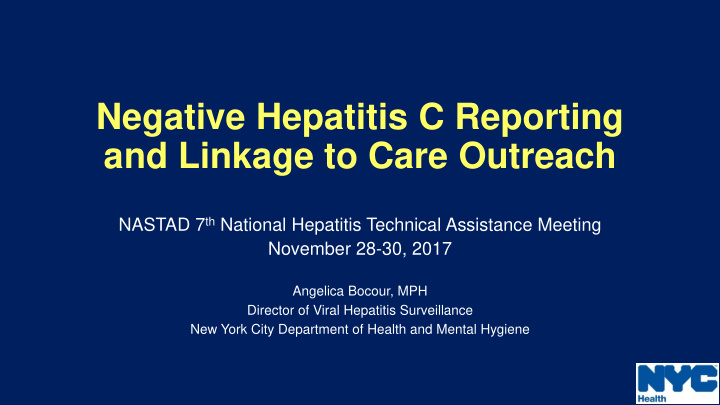



Negative Hepatitis C Reporting and Linkage to Care Outreach NASTAD 7 th National Hepatitis Technical Assistance Meeting November 28-30, 2017 Angelica Bocour, MPH Director of Viral Hepatitis Surveillance New York City Department of Health and Mental Hygiene
Hepatitis B and C Surveillance Registry • >90% electronically reported from laboratories • High volume of reports. In 2016: • >100,000 labs for hepatitis B • >200,000 labs for hepatitis C Hepatitis B labs Hepatitis C labs • Positive Core Antibody IgM, surface • Positive antibody antigen, “e” antigen, DNA, genotype • Positive and negative RNA results, • Negatives, non-reportables and ALTs Reportable genotype reported if on same accession as a • ALTs reported if on same reportable lab accession as a reportable lab • Core Antibody total, surface antibody, • Negative antibody tests Not “e” antibody reportable • Positive rapid antibody tests
Demographic Data Collected from Laboratory Reports • Name • Date of birth • Social security number • Sex Demographic • Age information received • Address at time of report • Current address • Phone number • Race/ethnicity • Country of birth Do not receive • Risk factors
New York City Communicable Disease Reporting • New York State maintains list of reportable diseases • New York City must conduct surveillance for these diseases • New York City Health Code Articles 11 and 13 • Require providers and laboratories to report positive and, in select cases, negative findings or markers of reportable diseases • Amendments proposed and approved by the Board of Health
Amend Health Code to Require Lab Reporting of All Hepatitis C RNA Results • For some conditions, receiving all laboratory results, not just those that are positive, greatly benefits disease surveillance (e.g., HIV viral load, hemoglobin A1C) • Accurately classify the proportion of New Yorkers previously infected who are currently infected • Identify providers and areas where screening, but not confirmatory testing, is performed to improve HCV care • Estimate the proportion of patients cured annually, as we do for HIV
Negative Hepatitis C RNA Reporting Implementation • Health Code change as of July 21, 2014 • Ensure laboratories report negative RNA tests • Check number of negative RNA tests by lab by month • Monitor percent of negative RNA tests by lab • Import results in Maven • Negative RNA results associated with patients already in Maven with a positive HCV test
Hepatitis C Treatment and Cure Algorithm • Treatment • Positive RNA test and a subsequent negative RNA test • Cure • First negative, indeterminate, or low positive (<1000 IU/mL) RNA result after most recent high positive RNA result (proxy for 4 weeks into treatment) • Based on this date: • At least 1 subsequent negative RNA test • Most recent negative RNA test is at least 4 months later • No subsequent high positive RNA (≥1000 IU/mL)
Treatment and Cure Algorithm Validation • Definitions validated using program data and chart reviews • High sensitivity, specificity, positive and negative predictive value HCV Program Data Chart review Treatment Sensitivity 94.5 93.2 Specificity 85.7 83.8 Positive predictive value 80.3 92.6 Negative predictive value 96.2 84.9 Cure Sensitivity 86.7 93.8 Specificity 98.3 89.4 Positive predictive value 65.0 89.1 Negative predictive value 99.5 93.9
Hepatitis C Linkage to Care • In 2016, ~11,000 people newly reported with hepatitis C • 3,781 confirmed infection (RNA positive), 2,684 antibody positive only • Prioritize cases for outreach based on current infection status • Exclude people whose last RNA test is negative (i.e., people who initiated treatment) • Linkage to care projects • Surveillance-based linkage to care • HIV/HCV co-infected individuals • Bronx RHIO (individuals with high fibrosis score)
Linkage to Care Case Management Tool in Maven
Require Reporting of Hepatitis B Negative DNA Test Results • Allow the Health Department to estimate the proportion of New Yorkers infected with hepatitis B virus who are appropriately linked to care • Identify gaps in access to care • Develop targeted interventions to increase linkage to care and improve provider knowledge of HBV testing and treatment guidelines • Increase monitoring of hepatitis B to decrease HBV-related morbidity and mortality
Hepatitis B Care Continuum Proposed ALGORITHM DEFINITIONS Linked to care defined as HBV DNA test within Definitions 6 months of newly reported HbsAg (current limitations = missing neg HBV DNA) Positive hepatitis B Treatment candidate defined as HBV DNA surface antigen >=2000 and ALT >40 Treatment initiation defined as treatment candidate followed by HBV DNA x 2 within 9 months No HBV DNA result could Timely linkage to care: No Viral load reduction defined as a declining mean not done or negative HBV DNA result within 6 HBV DNA viral load (>=1 log) in a test result in Need health code change months those in the treatment initiation group to receive all negatives Viral load suppression defined as HBV DNA Yes <60 IU/mL in those in the viral load reduction group HBV DNA ≥2000 Based on EASL 2017 Guidelines: http://www.sciencedirect.com/science/article/pii/ S016882781730185X No Yes No Yes Treatment At least 2 subsequent HBV Not treatment candidate ALT > 40 DNA within 9 months candidate based on labs No Yes No evidence Treatment of treatment initiation
Acknowledgements • New York City Department of Health and Mental Hygiene’s: • Viral Hepatitis Program • Miranda Moore, Kevin Guerra, Ann Winters • Bureau of Communicable Disease General Surveillance and Data Units • Division of Informatics and Information Technology • Rima Oken, Director of Policy, Division of Disease Control Angelica Bocour abocour@health.nyc.gov 347-396-7614
Recommend
More recommend